Tim Spector: You don’t need a restrictive diet for good gut health – just follow my 80:20 rule
After a mini-stroke forced gut health expert Tim Spector to rethink his own habits, he’s now on a mission to help others do the same. Hannah Twiggs talks to the ZOE co-founder about his new cookbook ‘Food for Life’ and why it’s not about always cutting out things, but adding more of the good stuff


When Tim Spector had a mini-stroke a few years ago while skiing in Italy, it was, to put it mildly, a surprise. He’d thought he was doing everything right. “Sandwiches and muesli seemed like sensible choices compared with fast-food burgers or doughnuts for breakfast,” he says in his new Food For Life Cookbook. As a health expert, it was the slap in the face he didn’t see coming.
Spector, the eminent professor of genetic epidemiology and gut health evangelist, has spent over a decade exploring the human microbiome and what it means to eat well. Now, he’s taken on a new challenge: dragging his audience out of the theory and into the kitchen, one bowl of lentil and mushroom lasagne at a time.
This latest offering is the logical next step for Spector’s series of bestsellers. “It’s a practical handbook, really,” he tells me. It complements the other books, which started with a gentle introduction to gut health 10 years ago, before spoon-feeding us facts about ultra-processed foods.
His last book, Food For Life, was more of a guide to everything edible, mapping out the broad principles of what it takes to eat well. “But there’s nothing quite like a practical guide with 100 examples to really bring it to life,” he says.
Which is why it is packed with approachable recipes built around Spector’s six guiding principles for eating well: eating 30 different plants a week, eating the rainbow (a colourful variety of fruit and veg), prioritising plant-based proteins, avoiding ultra-processed foods, incorporating fermented foods and, most importantly, listening to your body.
Spector says that after Food For Life, people kept asking, “What do I do now?” The answer is this: a step-by-step guide to bringing his six principles into your home. “How to make these healthy swaps and still have really attractive, tasty, delicious food that’s very cheap to eat,” he explains. He acknowledges that nutrition is a complicated business, but that’s no excuse to throw up your hands and order a double cheeseburger. “We love the simple solution, but that’s often an illusion,” he admits. His cookbook, he hopes, will help people navigate this complexity without losing their minds or their appetites.
What’s refreshing is Spector’s balance between scientific rigour and a healthy dose of realism. He’s no purist, and he doesn’t want his readers to be either. “Most diets have gone wrong because they insist on this pure approach and calorie counting, and if you fail one day, you’re off the wagon,” he says. Instead, he follows the “80 per cent rule”, which allows him to indulge occasionally without guilt. “If I can do these healthy things five days a week, that’s fine, but I’m not going to beat myself up if I’m in a place with nothing healthy to eat,” he says. “If there’s a nice crispy croissant and I don’t have my yoghurt, that’s fine. I’ll just accept it.”
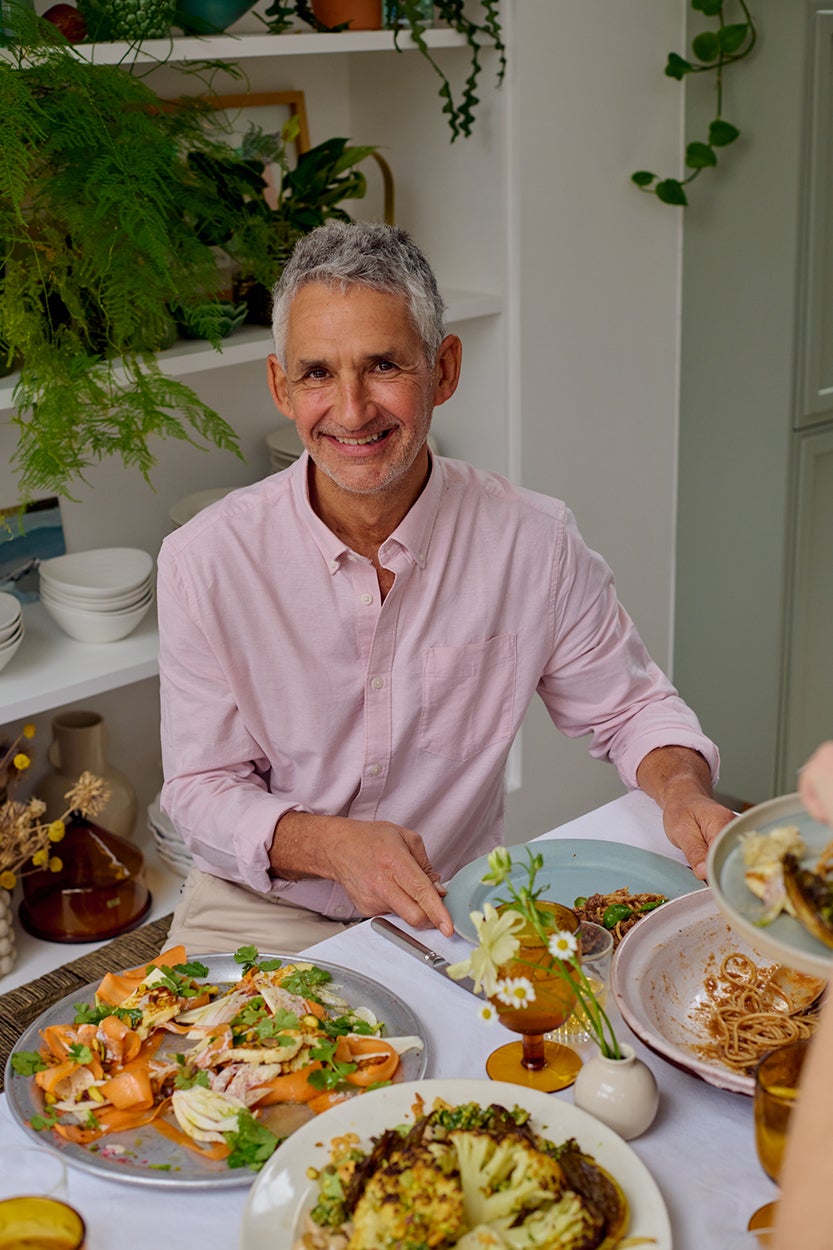
Spector is adamant that this is the only sustainable approach in the long run. “It’s really important to do something that is going to be a change that’s going to last for years and decades,” he says, “and is flexible enough to fit into that.” In the book, he stresses the importance of making healthy eating enjoyable, not punitive. And, “if you build up your gut microbes a bit, then they can cope with the odd burger or fried chicken every now and again, without them all dying off. They’ll be resistant.”
He wants to avoid the same restrictive mentality that has fuelled so many fads and dietary obsessions. “We don’t talk about portion sizes anywhere. We don’t talk about calories anywhere. Actually, what we’re talking about is adding things, eating more, but picking healthy things to add to your plate rather than removing anything.”
He continues: “We’re not saying there’s only one thing you need to avoid, whether it’s gluten or it’s lectins or whatever the fad is at the moment, which I think is where the problem of obsessional eating is coming from. We’re saying just eat real food, and there’s plenty of real food to choose from.”
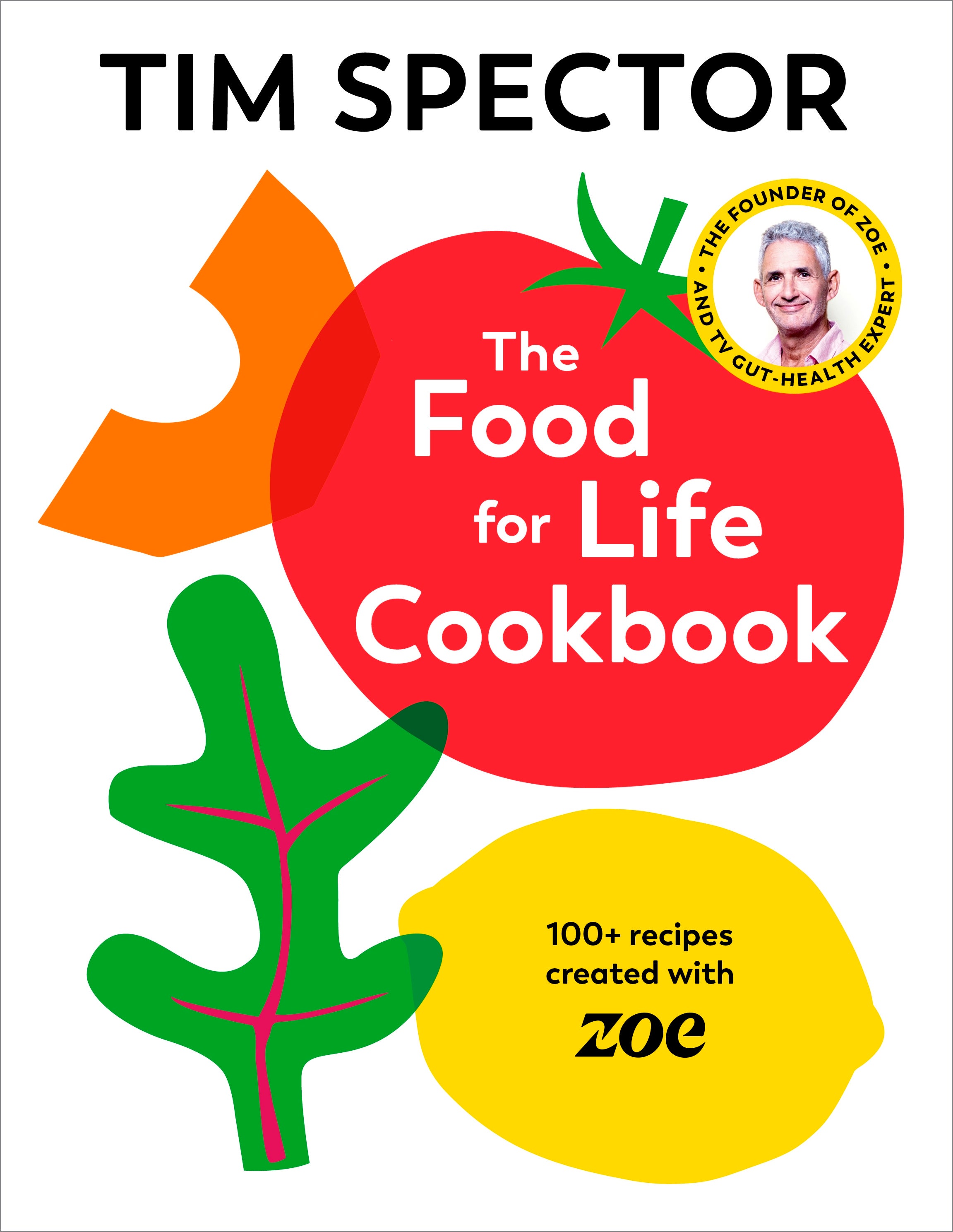
Of course, you can’t talk about Spector without mentioning ZOE, the personalised nutrition company he co-founded. The ZOE app promises to help users understand their unique biology, giving tailored advice based on gut microbiome tests and blood sugar responses. It’s a pioneering approach to eating well, but it hasn’t been without controversy. Critics have taken issue with some of the app’s claims and raised some questions about the research methods. There have been accusations that ZOE users, concerned about their gut health, have refused antibiotics – a rumour Spector dismisses as nonsense. “That’s not something we advocate or condone,” he said.
For Spector, criticism is par for the course. “If I was too nervous about it, I wouldn’t get up and be relaxed talking on live radio or TV or talking to journalists like you,” he says. He knows the stakes are high, but he has the confidence that comes with working in this field for the best part of 40 years. “Hopefully I always speak my mind, and be rude about the food industry and the people that are stopping us being healthy in this country.” He’s comfortable with making the occasional mistake if it means he can communicate effectively. “As long as most of the stuff I’m saying is doing good,” he adds.
For those new to gut health, Spector’s advice is simple: eat more plants. “Just trying to eat more plants and less meat, or a greater variety of plants,” he suggests. “Rather than one big blob of something, you’ve got multiple little ones, and you realise that, hey, it tastes good, and then it’s also better for you and fills you up more.”

But the Food For Life Cookbook isn’t just about swapping out your turkey twizzlers for quinoa and smugness. Some recipes serve as mission statements, reinforcing the idea that eating healthily isn’t about abandoning your old favourites – it’s about making them better.
There’s his version of a lasagne he grew up with, which swaps minced beef for lentils and mushrooms and trades the traditional bechamel for a creamy white bean sauce because those are better for your microbiome. “It still gives me that same comfort feeling,” he says, “I still get the burnt cheese on top that I love.” There’s also his take on Viennese schnitzel, made with aubergine instead of veal, which he says reminds him of being 18 and working in Austria. The message is clear: you can keep your nostalgia and eat well, too.
Spector is passionate about the need for a shift in focus from reactive medicine to preventive health, which will mean the government’s review into the NHS which is keen to explore more into that area will be music to his ears.
“As a country, we don’t think enough about lifestyle and preventive medicine and getting enough exercise and sleep and having a good diet,” he says. He urges readers to take their health into their own hands, rather than relying on the NHS to step in only once things have gone wrong. “We shouldn’t wait to have that mini-stroke or the mini-heart attack or the cancer,” he warns. “Just try to optimise your health, because it’s probably when things go wrong, we realise it’s the most important thing in our lives.”
Spector wants readers to see the new cookbook not as a rulebook, but as a flexible, sustainable way of thinking about what’s on their plate. And above all, he wants them to enjoy their food, to add variety and flavour, and to stop feeling guilty about the occasional treat.
“Food,” he writes in the book, “is the perfect combination of science and pleasure; the more I learn, the better it tastes.”
Roasted aubergine traybake
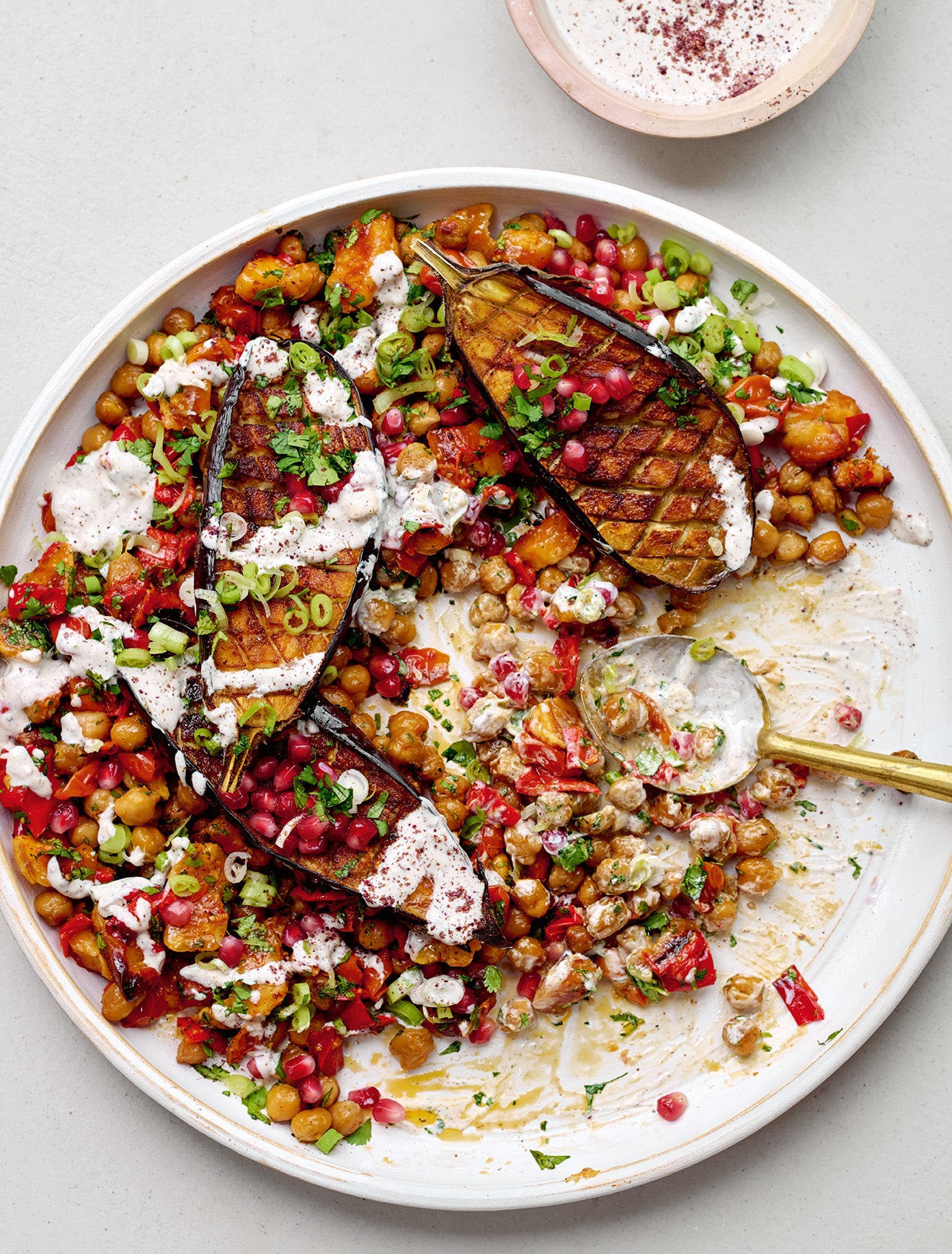
Traybakes are so simple to make, but the garnishes here make it look like a showstopper and bring the plant score up to 13, giving you plenty of polyphenols and a boost of fibre. The best entertaining recipes require very little active time in the kitchen, and this one fits the brief. Prepare the tray for baking in advance and pop it in the oven for 40 minutes before you plan to serve.
Serves: 4
Prep time: 15 minutes | Cooking time: 40 minutes
Ingredients:
2 x 400g tins chickpeas, drained and patted dry
350g cherry tomatoes
2 peppers, cut into 2cm chunks
200g halloumi, cut into 1cm cubes
3 garlic cloves, unpeeled
2½ tsp ground cumin
1½ tsp ground coriander
1 tsp chilli powder
4 tbsp extra virgin olive oil
2 aubergines, halved
3 tbsp tahini
180ml kefir
2 tsp sumac
20g coriander, roughly chopped
4 spring onions, thinly sliced
3 tbsp pomegranate seeds
Juice of lime
Salt and black pepper
Top-ups:
Sauerkraut
Swaps:
Firm tofu for halloumi
Plant-based yoghurt for kefir
Method:
1. Preheat the oven to 200C/180C fan/400F/gas 6 and line two large baking trays with baking parchment.
2. Put the chickpeas, tomatoes, peppers, halloumi and garlic cloves on one tray with three-quarters each of the cumin, ground coriander and chilli powder. Season with salt and pepper and drizzle with 3 tablespoons of olive oil. Toss to coat.
3. Cut each aubergine in half lengthways and score a 2cm deep criss-cross pattern into the flesh of each one. Sprinkle with the remaining ground spices and drizzle with the remaining olive oil, season and place on the other baking tray. Place both trays in the oven for 40 minutes.
4. Mix the tahini, kefir and sumac in a bowl and season. When the vegetables are ready, squeeze the garlic from their skins into the sauce, mash them in and stir to combine.
5. Transfer the chickpeas, halloumi and veg to a serving dish and stir in three-quarters of the fresh coriander. Place the aubergine halves on top and scatter with the remaining coriander, spring onions, pomegranate seeds, lime juice and the sauce.
Creamy kale pasta
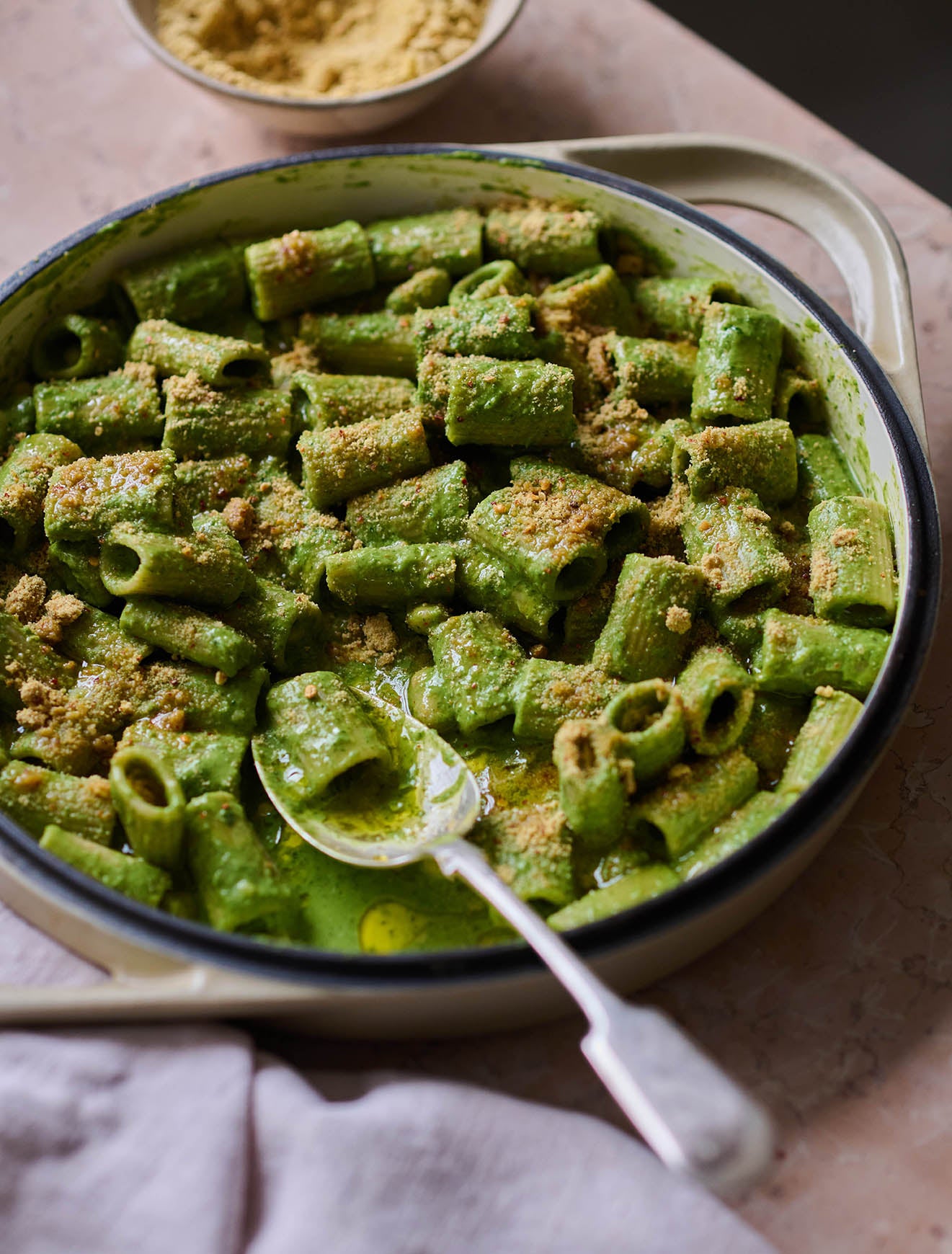
A good pasta can be so satisfying, and this recipe improves the nutritional value by adding our beloved fibre-packed beans, which also make the sauce creamy and delicious. Including extra seeds on top will bring a delightful crunch, plus added fibre, good fats and protein.
Serves: 2
Prep time: 5 minutes | Cooking time: 10 minutes
Ingredients:
90g wholewheat pasta
100g kale or cavolo nero, stalks removed and thinly sliced
1 garlic clove
Juice of 1 lemon
2 tbsp nutritional yeast or parmesan
1 x 400g tin cannellini beans and their liquid
Salt and black pepper
Top-ups:
Sauerkraut
Seeds
Method:
1. Bring two saucepans of salted water to the boil. Put the pasta in one and cook for 8-10 minutes, or until al dente.
2. Put the kale and garlic in the other saucepan and blanch for 3 minutes. When ready, drain and add to a blender with the lemon juice and nutritional yeast .
3. Pour the beans into a sieve set over a bowl, keeping the liquid from the tin. Add a quarter of the beans to the blender along with the reserved liquid and blitz until totally smooth.
4. When the pasta is ready, drain it, reserving 2 tablespoons of the cooking water. Return to the pan with the remaining cannellini beans, reserved cooking water and the blended sauce. Heat through for a minute or so, taste and season if necessary and serve.
Carrot cake with tahini orange frosting
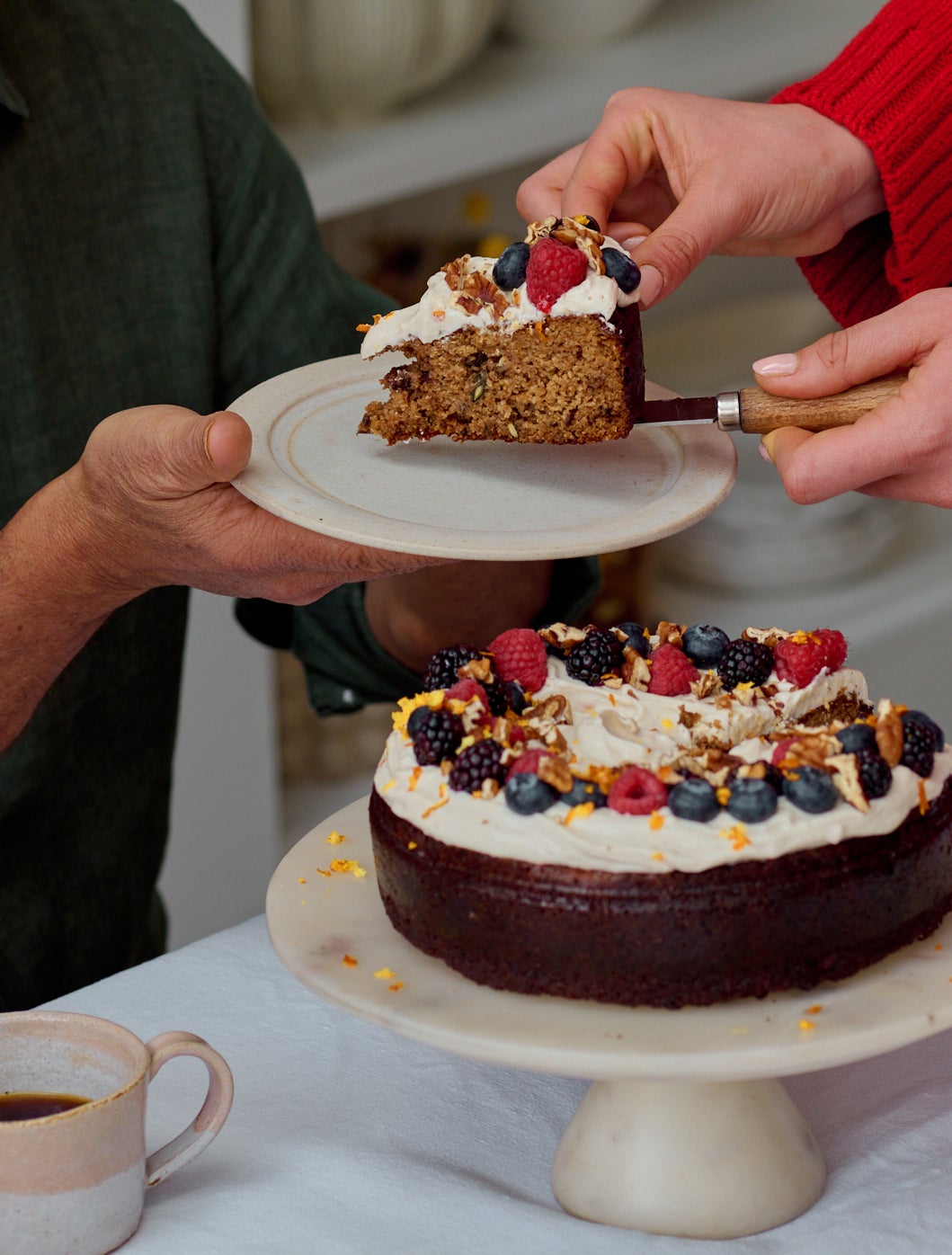
For moments when your cup of tea needs a slice of cake, this one really packs in the plants, and the Greek yoghurt “frosting” adds a lovely tartness – just be mindful it won’t set like usual frosting. The added benefit of the yoghurt is that the protein and fat will help slow the absorption of sugar into your bloodstream from the cake.
Makes: 8-10 slices
Prep time: 15 minutes | Cooking time: 50 minutes
Ingredients:
85ml extra virgin olive oil, plus extra for greasing
100ml kefir
3 eggs
4 tbsp honey
85g soft light brown sugar
285g ground almonds
2 tbsp ground cinnamon
4 tbsp pumpkin seeds
50g walnuts, roughly chopped
2 tsp baking powder
1 tsp bicarbonate of soda
Pinch of salt
200g carrots, grated
For the topping:
185g Greek yoghurt
2 tbsp tahini
1 tsp vanilla extract
1 tsp honey
Zest of ½ orange
2 tbsp pumpkin seeds
Top-ups:
Fresh berries
Walnuts
Method:
1. Preheat the oven to 180C/160C fan/350F/gas 4 and grease and line a 20cm round springform cake tin.
2. Put the olive oil, kefir, eggs, honey and sugar in a bowl and mix to combine. Add the ground almonds, cinnamon, pumpkin seeds, walnuts, baking powder, bicarbonate of soda and salt and mix everything until thoroughly combined.
3. Fold in the carrots and then transfer the mixture to the lined tin. Flatten with a spatula and bake for 45-50 minutes, or until a metal skewer inserted in the middle comes out clean. Allow to cool completely before removing from the tin.
4. Meanwhile, make the topping: mix the Greek yoghurt, tahini, vanilla extract, honey and orange zest in a bowl – it will thicken slightly. Spread all over the cooled cake and finish with the pumpkin seeds. Store in the fridge, covered, for up to 5 days.
Recipes from ‘The Food for Life Cookbook’ by Tim Spector (Jonathan Cape, £28).






Join our commenting forum
Join thought-provoking conversations, follow other Independent readers and see their replies
Comments